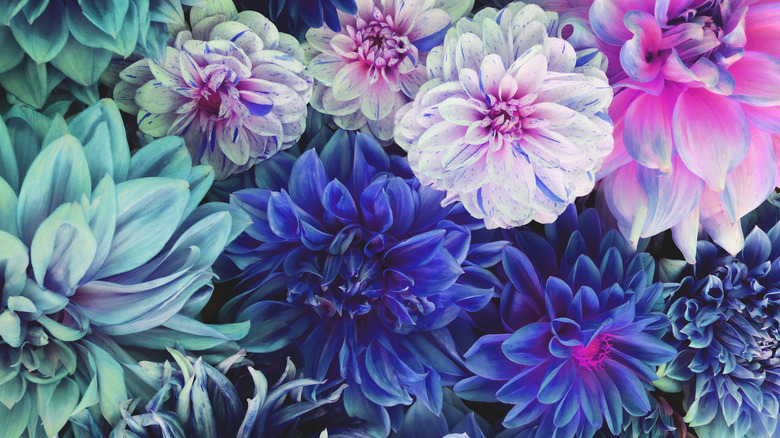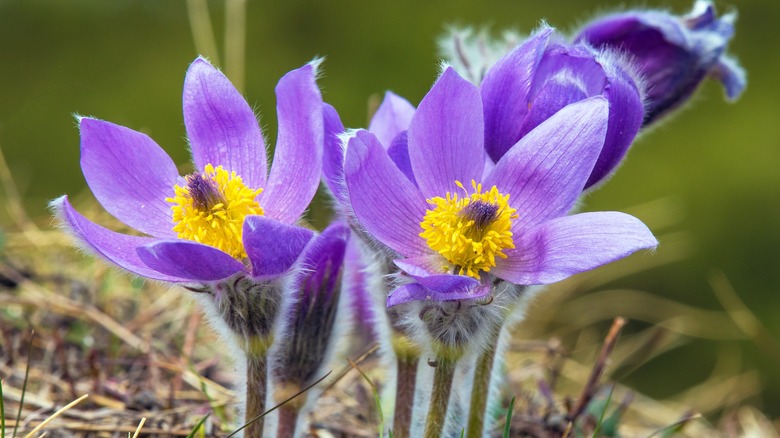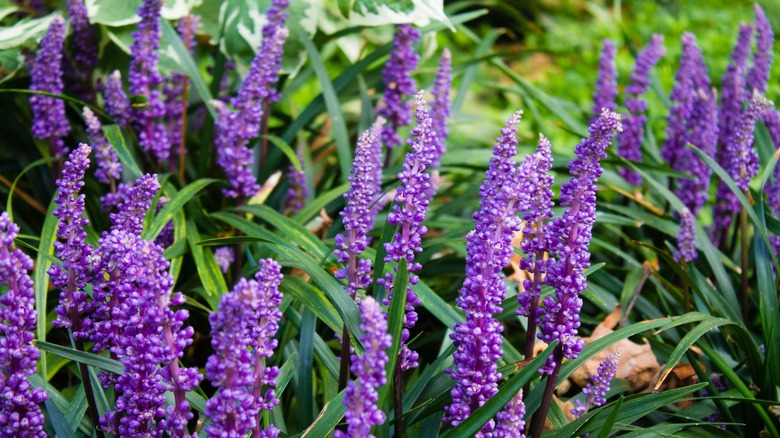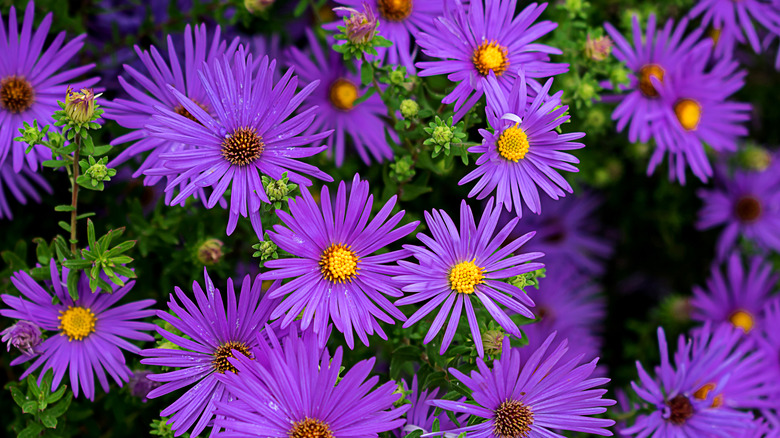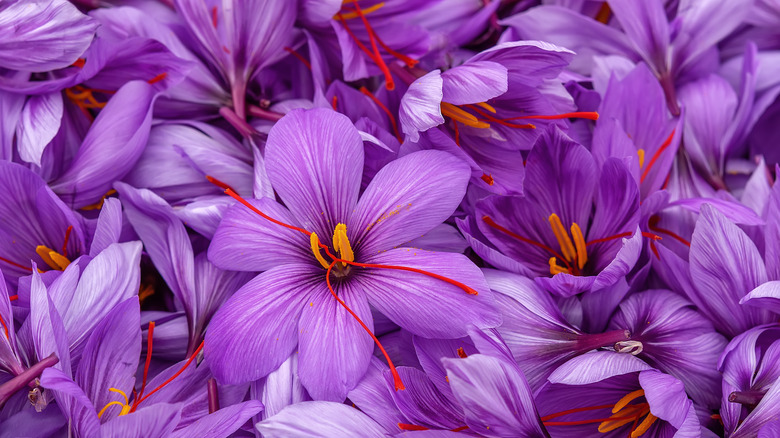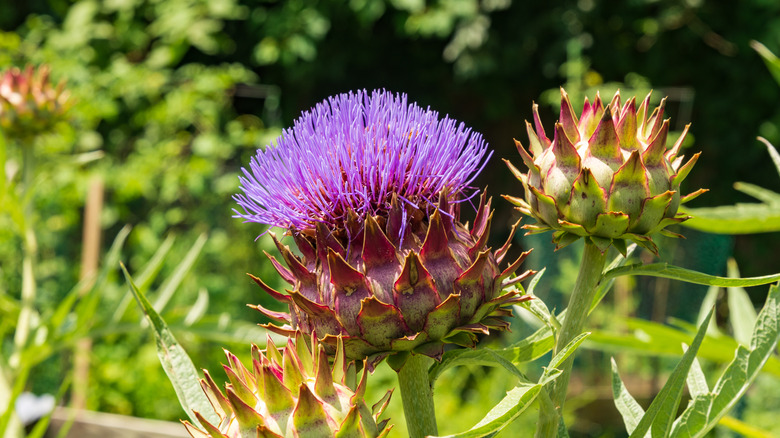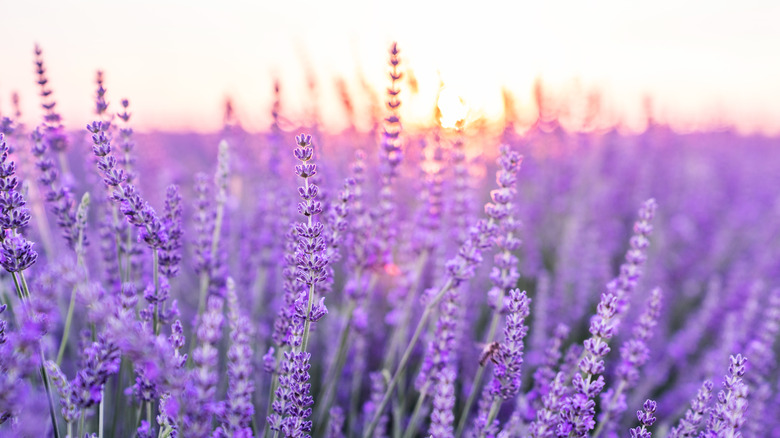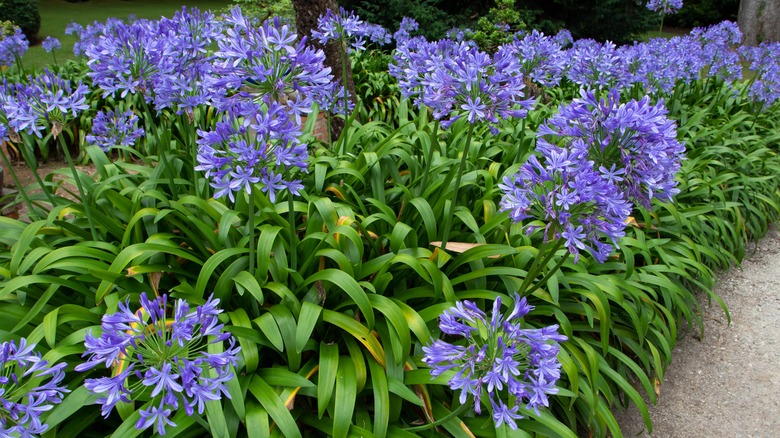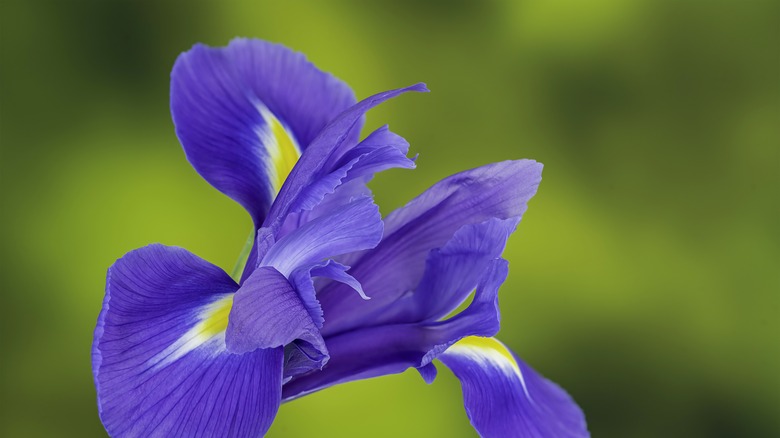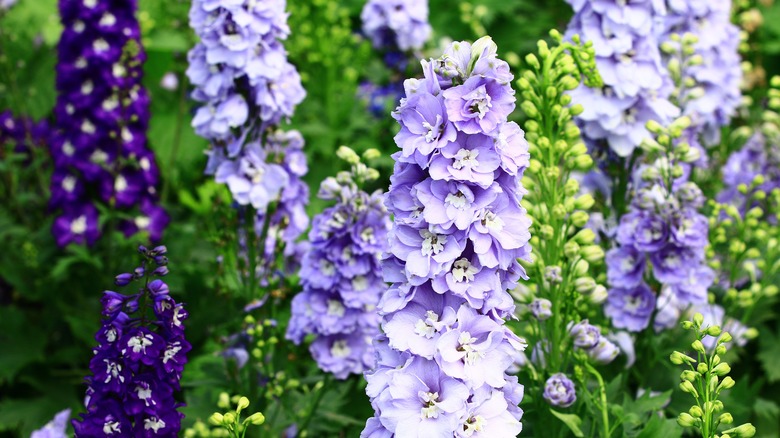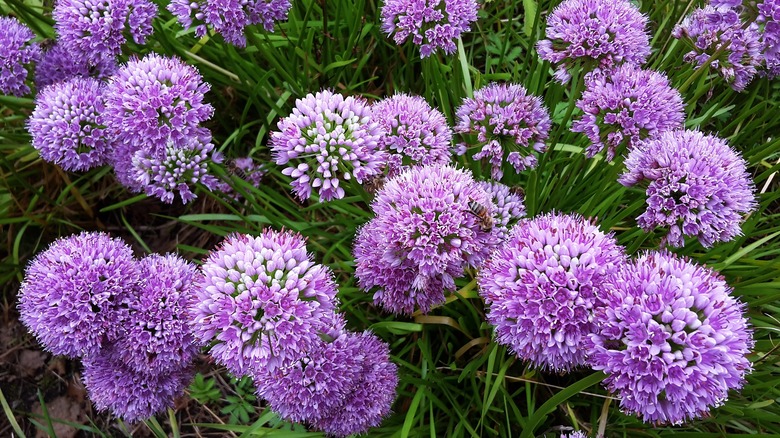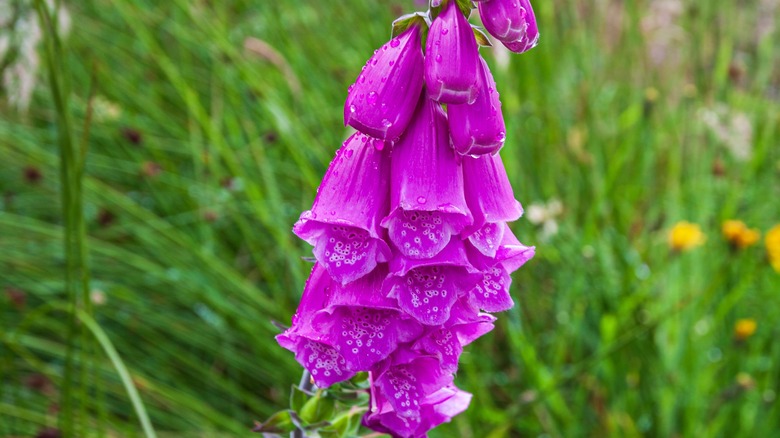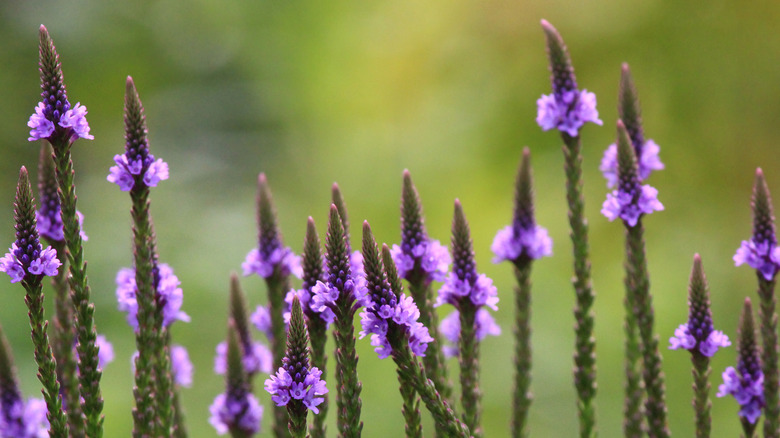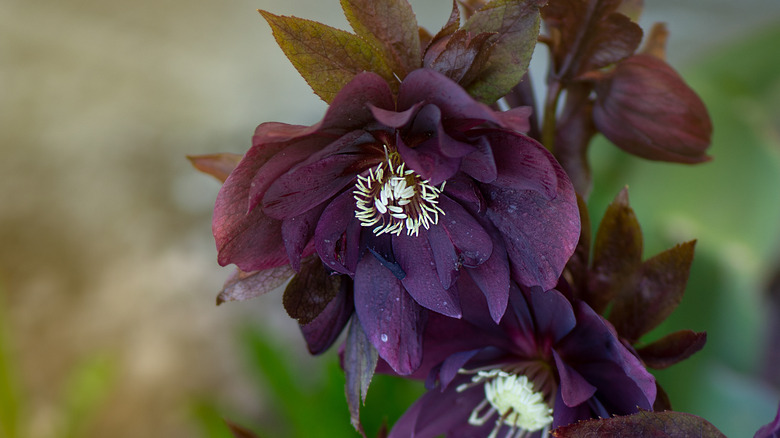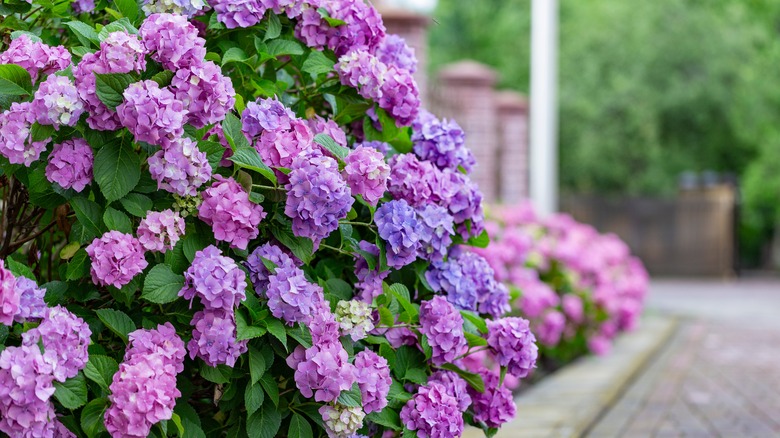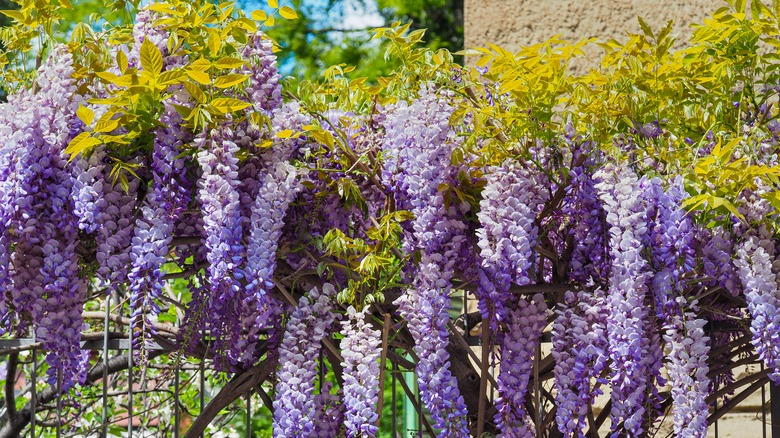15 Perennials That Bloom With Gorgeous Purple Flowers
If purple is your favorite color, then choosing flowers blooming in this hue for your garden is an easy choice to make. This royal tint is a very vibrant color and comes in many different shades. Besides, purple blooms paired with green foliage create an especially eye-catching combo in any outdoor space. According to Gardening Chores, you have a large selection to choose from when it comes to perennials with purple-blooming flowers. Moreover, most of the varieties are easy to care for, making them even more appealing.
This color, being a mix of red and blue, evokes thoughts of royalty. Sensational Color notes that blue is a calming hue and red is well known as the color of love, and as such, the two colors combined into one make it a great choice for gardens, promoting peace and awareness. Perennials bloom every year, so once you've planted your favorite selection of purple blooms, you can sit back and enjoy the floral show every year, with minimal work involved.
1. Pasqueflower
Pasqueflower (Pulsatilla vulgaris) has big purple flowers with bright yellow centers. This variety is also known as the Easter flower, belongs to the same family as the buttercup, and is great for borders and rock gardens. According to the University of Wisconsin-Madison, it comes from the U.K., where it finds its home in the meadows.
Bloom Season: Spring
USDA Growing Zone: 4-8
Growing Conditions: Full sun
Soil Type: Loamy and well-draining
Size: Up to 1 foot tall
2. Lily turf
Lily turf (Liriope muscari) has a stunning lilac color and looks elegant and decorative. Seasonal Gardening comments that during fall, when this plant has finished blooming, it will produce round, black berries that, while inedible, add a bit of something extra to your garden. The perennial is used mainly as ground cover in gardens.
Bloom Season: Spring
USDA Growing Zone: 5-10
Growing Conditions: Full sun
Soil Type: Loamy, moist, and well-draining
Size: Up to 18 inches tall
3. Purple aster
Aster 'Wood's Purple' (Aster dumosus 'Wood's Purple) is a plant that has lots of blooms. They are colored in a pale purple with a yellow center and boast dark emerald green foliage that sets off the heavily petalled flowers perfectly. PerennialResource says this perennial works well in borders or as an underplant, under roses bushes and such, so long as there isn't too much shade.
Bloom Season: Spring
USDA Growing Zone: 3-8
Growing Conditions: Full sun
Soil Type: Moist but well-draining
Size: Up to 18 inches tall
4. Saffron crocus
Saffron crocus (Crocus sativus) blooms with pretty little flowers with distinct petals in glorious shades of purple. They can be grown easily anywhere, from tubs to lawns to rockeries. The crocus stamens, when dried, form the legendary and expensive spice known as saffron. Farmer Gracy says that you can harvest your saffron if you wish as soon as the fall unfolds.
Bloom Season: Autumn
USDA Growing Zone: 5-8
Growing Conditions: Full sun
Soil Type: Loamy and well-draining
Size: Up to 18 inches tall
5. Cardoon
Cardoon (Cynara carbuncular) is a beautiful thistle flower that is unique and unusual with an array of bluish purple petals; it adds a touch of wildness to any garden. Spadefoot Nursery says the cardoon is closely related to the artichoke; it also is edible, with a flavor between a chestnut and an artichoke.
Bloom Season: Late summer to autumn
USDA Growing Zone: 7-10
Growing Conditions: Full sun
Soil Type: Well draining
Size: Up to 5 feet tall
6. Lavender
Lavender (Lavendula) might be one of the first plants you think of when you imagine purple flowers. Highly scented and distinctive, it looks great in pots, borders, or grown in large amounts, almost resembling a bush. With several varieties, whether you opt for English, French, or Spanish, Garden Design says that lavender has hues ranging from pale violet to deep purple, so there is something for everyone.
Bloom Season: Spring or summer depending on the variety
USDA Growing Zone: 5-8
Growing Conditions: Full sun
Soil Type: Well draining
Size: 20-24 inches tall
7. African lily
African lily (Agapanthus) has beautiful blue-purple flowers and benefits from being in partial shade if the climate is particularly warm. Alternatively, a full sun location would be best if planted in a cooler area. These plants are native to South Africa and are easy to grow, and their large flower heads make them very popular, says Plantura Magazine.
Bloom Season: April
USDA Growing Zone: 8-11
Growing Conditions: Full sun in cooler areas, partial shade in warm climates
Soil Type: Slightly alkaline, fertile, well-draining
Size: Up to 3 feet tall
8. Iris
Iris (Iris germanica) has very distinctive-shaped flowers. Beautiful and delicate, they come in a variety of colors, which include two shades of purple. The Royal Horticultural Society state that they are hardy, clump-forming perennials and can be used in borders, rockeries, or pots. Iris is perfect for seasoned gardeners since it needs pruning each year after blooming.
Bloom Season: Spring
USDA Growing Zone: 3-9
Growing Conditions: Full sun
Soil Type: Loamy and well-draining
Size: Up to 3 feet tall
9. Candle larkspur
Candle larkspur (Delphinium elatum) is so named, according to PictureThis, because its flowers have the scent of candles. The blooms are collected at the end of each stem in long, graceful rows, not dissimilar in appearance to hyacinth. This plant is mainly used as a flower bed and border flower in gardens.
Bloom Season: Summer to autumn, if well cared for
USDA Growing Zone: 4-8
Growing Conditions: Full sun
Soil Type: Moist and well-draining
Size: Up to 1 foot
10. Millenium flowering onion
Millenium flowering onion (Allium millenium) has large, purple, lollipop-style flower heads that can be used to create a stunning centerpiece or frame borders elegantly. The round cluster sits atop a long single stem that can grow as tall as 6 feet, but if planted in full sun, they grow straight up and sheltered from strong winds; even the tallest ones shouldn't need staking as the stems are strong and sturdy, states Sarah Raven.
Bloom Season: Summer
USDA Growing Zone: 3-9
Growing Conditions: Full sun
Soil Type: Loamy and well-draining
Size: Up to 6 feet tall
11. Foxglove
Foxgloves (Digitalis purpurea) are tall perennials with rows of purple, bell-shaped flowers growing on the top part of each stem. They love to be in a sunny position in the garden, and as they can be prone to crown rot, the soil type you use is important, says PictureThis. They also note that all parts of this plant are poisonous if ingested, so handle it with care.
Bloom Season: Summer to early autumn
USDA Growing Zone: 4-9
Growing Conditions: Full sun, partial shade if particularly hot
Soil Type: Loamy and well-draining
Size: Up to 6 feet
12. Vervain
Vervains (Verbena officinalis) are tall, thin, and spiky wildflowers that were used in the Middle Ages to treat a variety of ailments and grow in the south of England and Wales. Despite initially looking unassuming, they can be grown in pots or borders to beautify any garden. Vervians also tolerate frost well.
Bloom Season: Summer to early autumn
USDA Growing Zone: 3-9
Growing Conditions: Full sun
Soil Type: Loamy and well-draining
Size: Up to 5 feet tall
13. Hellebore
Hellebore (Helleborus) is known as a winter plant. Flowering from late winter through spring, this clump-forming perennial thrives best in soil that's loamy enough to ensure even water distribution. The Royal Horticultural Society says that hellebores are generally small in stature and are often called Christmas roses, as they flower in winter, but they aren't related to the Rose family; they stem from the Buttercup family.
Bloom Season: Winter
USDA Growing Zone: 3-9
Growing Conditions: Shade
Soil Type: Fertile and well-draining
Size: Up to 18 inches tall
14. Hydrangea
Hydrangea (Hydrangea macrophylla) is a shrub-like plant that can grow quite large depending on the variety you choose. Gilmour says that the shade of the bloom also depends on the soil's acidity. More acid soil, pH 5.5 or lower, will produce a bluer flower, whereas soil with a pH higher than 5.5 will be more of a pinky purple.
Bloom Season: Spring and summer
USDA Growing Zone: 3-7
Growing Conditions: Partial shade
Soil Type: Clay
Size: Up to 3 or 6 feet tall and wide, depending on the variety
15. Wisteria
Wisteria (Wisteria floribunda or Wisteria sinensis) is a climbing shrub that needs good support to thrive, says The Sunday Gardener, and as such, it isn't suitable for a small trellis. However, it can grow very tall and is perfect for setting it up on the side of a house. The flowers are delicate, trailing blooms that have a heady scent.
Bloom Season: Spring and summer
USDA Growing Zone: 5-8
Growing Conditions: Full sun with partial shade
Soil Type: Loamy and well-draining
Size: Can grow up to 30 feet tall
